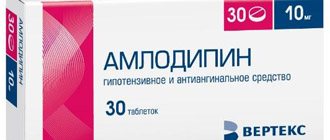Nolpaza tablet p o intestinal 20 mg pack cont cell/pack card x56
ATX code: A02BC02 (Pantoprazole) Active substance: pantoprazole (pantoprazole) Rec.INN registered by WHO Dosage form NOLPAZA tablet, coated. enteric coated, 20 mg: reg. No.: LSR-009049/08 dated 11/19/08 - Registration period. beat not limited Release form, composition and packaging Tablets, enteric-coated, light yellowish-brown in color, oval, slightly biconvex, at the break - a mass from white to light yellowish-brown, with a rough surface, with a layer of light yellowish-brown coating.
1 tab. pantoprazole sodium sesquihydrate 22.55 mg, which corresponds to the content of pantoprazole 20 mg
Excipients: mannitol, crospovidone, anhydrous sodium carbonate, sorbitol, calcium stearate.
Shell composition: hypromellose, povidone, titanium dioxide (E171), iron dye yellow oxide (E172), propylene glycol, Eudragit L30D dispersion (copolymer of methacrylic acid and ethyl acrylate (1:1) dispersion 30%, water, sodium lauryl sulfate, polysorbate-80) , talc, macrogol 6000.
Clinical and pharmacological group: H+-K+-ATPase inhibitor. Antiulcer drug Pharmacotherapeutic group: Proton pump inhibitor Pharmacological action Antiulcer drug. Inhibits the enzyme H+-K+-ATPase (proton pump) in the parietal cells of the stomach and thereby blocks the final stage of hydrochloric acid synthesis. This leads to a decrease in the level of basal and stimulated secretion of hydrochloric acid, regardless of the nature of the stimulus.
After a single oral dose of 20 mg, the effect of pantoprazole develops within the first hour, the maximum effect is achieved after 2-2.5 hours. It does not affect gastrointestinal motility. After stopping the drug, secretory activity is completely restored after 3-4 days.
Pharmacokinetics Absorption
Pantoprazole is rapidly absorbed from the gastrointestinal tract, Cmax is reached 2-2.5 hours after oral administration and is 1-1.5 mcg/ml, while the Cmax value remains constant with repeated doses. The bioavailability of the drug is 77%. Simultaneous food intake does not affect AUC, Cmax and bioavailability; only a change in the onset of action of the drug is observed.
Distribution
Plasma protein binding is about 98%. Vd is approximately 0.15 l/kg, and clearance is 0.1 l/h/kg.
Metabolism
Pantoprazole is almost completely metabolized in the liver. It is an inhibitor of the CYP2C19 isoenzyme.
Removal
T1/2 - 1 hour. Due to the specific binding of pantoprazole to the proton pump of parietal cells, T1/2 does not correlate with the duration of the therapeutic effect. Excretion of metabolites (80%) is mainly through the kidneys, the remainder is excreted in bile. The main metabolite detected in serum and urine is desmethylpantoprazole, which is conjugated with sulfate. T1/2 of desmethylpantoprazole (approximately 1.5 hours) is much longer than T1/2 of pantoprazole itself.
Pharmacokinetics in special clinical situations
In case of chronic renal failure (including in patients on hemodialysis), no change in dosage of the drug is required. T1/2 is short, as in healthy individuals. Pantoprazole can be excreted in very small quantities during dialysis.
In patients with liver cirrhosis (classes A and B on the Child-Pugh scale), when taking pantoprazole at a dose of 20 mg/day, T1/2 increases to 3-6 hours, AUC increases by 3-5 times, and Cmax increases by 1.3 times. compared to healthy individuals.
The slight increase in AUC and increase in Cmax in elderly patients compared with the corresponding data in younger patients are not clinically significant.
Indications: gastroesophageal reflux disease (GERD), incl. erosive and ulcerative reflux esophagitis and symptoms associated with GERD (heartburn, acid regurgitation, pain when swallowing),
- erosive and ulcerative lesions of the stomach and duodenum associated with taking NSAIDs,
- peptic ulcer of the stomach and duodenum, treatment and prevention,
— eradication of Helicobacter pylori in combination with two antibiotics,
- Zollinger-Ellison syndrome and other pathological conditions associated with increased gastric secretion.
ICD-10 codes ICD-10 code Indication E16.8 Other specified disorders of endocrine pancreas (including Zollinger-Ellison syndrome) K21 Gastroesophageal reflux K21.0 Gastroesophageal reflux with esophagitis K25 Gastric ulcer K26 Duodenal ulcer K27 Peptic ulcer Y45 Analgesic, antipyretic and anti-inflammatory drugs
Dosage regimen The drug is taken orally. The tablet should be swallowed whole, without chewing or breaking, with a small amount of liquid, before meals, usually before breakfast. When taken twice, the second dose of the drug is recommended to be taken before dinner.
For GERD, incl. erosive and ulcerative reflux esophagitis and associated symptoms (heartburn, acid regurgitation, pain when swallowing) mild, recommended dose - 20 mg/day, moderate and severe - 40-80 mg/day. Relief of symptoms usually occurs within 2-4 weeks. The course of therapy is 4-8 weeks.
For prevention, as well as as long-term maintenance therapy, 20 mg/day is prescribed, if necessary, the dose is increased to 40-80 mg/day. The drug can be taken “on demand” if symptoms occur.
For erosive and ulcerative lesions of the stomach and duodenum associated with taking NSAIDs, the recommended dose is 40-80 mg/day. The course of therapy is 4-8 weeks.
For the prevention of erosive lesions during long-term use of NSAIDs - 20 mg.
For the treatment and prevention of gastric and duodenal ulcers, 40-80 mg/day is prescribed. The course of treatment for exacerbation of duodenal ulcer is usually 2 weeks, for gastric ulcer - 4-8 weeks. If necessary, the duration of therapy is increased.
For eradication of Helicobacter pylori (in combination with antibiotics), the recommended dose is 40 mg 2 times a day in combination with two antibiotics, usually the course of anti-Helicobacter pylori therapy is 7-14 days.
For Zollinger-Ellison syndrome and other pathological conditions associated with increased gastric secretion, the recommended starting dose of long-term therapy with pantoprazole is 80 mg/day, divided into 2 doses. In the future, the daily dose can be titrated depending on the initial level of gastric secretion. It is possible to temporarily increase the daily dose of pantoprazole to 160 mg in order to adequately control gastric secretion. The duration of therapy is selected individually.
In patients with severely impaired liver function, the dose of pantoprazole should not exceed 40 mg/day and it is recommended to regularly monitor the activity of liver enzymes, especially during long-term treatment with pantoprazole. If the activity of liver enzymes increases, it is recommended to discontinue the drug.
In elderly patients and patients with kidney disease, the maximum daily dose of pantoprazole is 40 mg.
In elderly patients receiving Helicobacter pylori eradication therapy, the duration of therapy usually does not exceed 7 days.
Side effects From the hematopoietic organs: very rarely - leukopenia, thrombocytopenia.
From the digestive system: often - abdominal pain, diarrhea, constipation, flatulence, infrequently - nausea, vomiting, rarely - dry mouth, very rarely - increased activity of liver transaminases and GGT, severe liver damage leading to jaundice with liver failure or without.
From the immune system: very rarely - anaphylactic reactions, including anaphylactic shock.
From the musculoskeletal system: rarely - arthralgia, very rarely - myalgia.
From the central nervous system and peripheral nervous system: often - headache, infrequently - dizziness, visual impairment (blurred vision), very rarely - depression.
From the genitourinary system: very rarely - interstitial nephritis.
Allergic reactions: infrequently - itching, rash, very rarely - urticaria, angioedema, Stevens-Johnson syndrome, erythema multiforme or Lyell's syndrome, photosensitivity.
Other: very rarely - peripheral edema, hyperthermia, weakness, painful tension of the mammary glands, increased triglyceride levels.
If severe adverse effects develop, treatment with the drug should be discontinued.
Contraindications for use: dyspepsia of neurotic origin,
- children and adolescents under 18 years of age (efficacy and safety have not been studied),
- hypersensitivity to pantoprazole or other components of the drug.
Nolpaza contains sorbitol, so the drug is not recommended for patients with rare hereditary fructose intolerance.
The drug should be prescribed with caution during pregnancy, lactation, liver failure, and risk factors for cyanocobalamin deficiency (especially against the background of hypo- and achlorhydria).
Use during pregnancy and lactation There is limited experience with the use of pantoprazole in pregnant women. During pregnancy and breastfeeding, it can be used only if the positive effect for the mother justifies the possible risk for the fetus and child. There is no data on the excretion of pantoprazole in breast milk.
Use for liver dysfunction In patients with severe liver dysfunction, the dose of pantoprazole should not exceed 40 mg/day and it is recommended to regularly monitor the activity of liver enzymes, especially during long-term treatment with pantoprazole. If the activity of liver enzymes increases, it is recommended to discontinue the drug. Use for impaired renal function In patients with kidney disease, the maximum daily dose of pantoprazole is 40 mg. Use in children Contraindicated: children under 18 years of age (efficacy and safety have not been studied). Use in elderly patients In elderly patients receiving Helicobacter pylori eradication therapy, the duration of therapy usually does not exceed 7 days. Special instructions Before starting therapy, it is necessary to exclude the presence of a malignant neoplasm (endoscopic control, if necessary with a biopsy - especially with a gastric ulcer), because Treatment, masking symptoms, can delay the correct diagnosis.
If after 4 weeks of therapy with pantoprazole the patient does not have the desired therapeutic effect, he should undergo a re-examination.
Like other proton pump inhibitors, pantoprazole may reduce the absorption of cyanocobalamin (vitamin B12) due to hypo- and achlorhydria. This should be especially taken into account during long-term treatment and in patients with risk factors for vitamin B12 deficiency.
Long-term therapy, especially lasting more than 1 year, requires regular monitoring of the patient.
Impact on the ability to drive vehicles and operate machinery
The drug does not affect the ability to drive a car or other technical equipment.
Overdose Symptoms of overdose in humans are not known.
Treatment: There is no specific antidote. In case of overdose of the drug, accompanied by the usual signs of intoxication, detoxification measures are used. Treatment is symptomatic.
Drug interactions Nolpaza reduces the absorption of drugs whose bioavailability depends on the pH of the stomach and those absorbed at acidic pH values (for example, ketoconazole).
Pantoprazole is metabolized in the liver via the cytochrome P450 enzyme system. Interactions between pantoprazole and drugs that are metabolized by the same system cannot be excluded. However, clinical studies showed no significant interactions with digoxin, diazepam, diclofenac, ethanol, phenytoin, glibenclamide, carbamazepine, caffeine, metoprolol, naproxen, nifedipine, piroxicam, theophylline and oral contraceptives.
Although no significant interaction was identified when used concomitantly with warfarin in clinical pharmacokinetic studies, there were a few isolated reports of changes in MHO. In patients receiving coumarin anticoagulants concomitantly with pantoprazole, regular monitoring of prothrombin time or MHO is recommended.
No drug interactions have been reported when pantoprazole is taken concomitantly with antacids.
Conditions for dispensing from pharmacies The drug is dispensed with a prescription. Conditions and periods of storage The drug should be stored out of the reach of children at a temperature not exceeding 30°C. Shelf life: 3 years.
Nolpaza, 28 pcs., 20 mg, enteric-coated tablets
For enteric-coated tablets
Inside,
The tablet should not be chewed or broken. Swallow the tablet whole with a small amount of liquid before meals, usually before breakfast. When taken twice, the second dose of the drug is recommended to be taken before dinner.
GERD, incl. erosive and ulcerative reflux esophagitis and associated symptoms: heartburn, acid regurgitation, pain when swallowing:
- mild: recommended dose - 1 tablet. Nolpaza® drug 20 mg/day;
- moderate and severe: recommended dose - 1-2 tablets. Nolpaza® drug 40 mg/day (40–80 mg/day). Relief of symptoms usually occurs within 2–4 weeks. The course of therapy is 4–8 weeks. For prophylaxis, as well as for long-term maintenance therapy, take 20 mg/day (1 tablet of Nolpaza®, 20 mg), if necessary, increase the dose to 40–80 mg/day. The drug can be taken on demand if symptoms occur.
Erosive and ulcerative lesions of the stomach and duodenum associated with taking NSAIDs:
Recommended dosage: 1–2 tablets. Nolpaza® 40 mg (40–80 mg/day). The course of therapy is 4–8 weeks. For the prevention of erosive lesions during long-term use of NSAIDs - 20 mg.
Peptic ulcer of the stomach and duodenum (treatment and prevention)
- Prescribe 40–80 mg/day. The course of treatment for exacerbation of duodenal ulcer is usually 2 weeks, for gastric ulcer - 4-8 weeks. If necessary, the duration of therapy is increased.
Eradication of Helicobacter pylori (in combination with antibiotics):
recommended dose - 1 tablet. Nolpaza® (40 mg) 2 times a day in combination with two antibiotics, usually the course of anti-Helicobacter therapy is 7–14 days.
Zollinger-Ellison syndrome and other pathological conditions associated with increased gastric secretion:
The recommended starting dose of long-term therapy with pantoprazole is 80 mg (2 tablets of Nolpaza®, 40 mg each) per day, divided into 2 doses. In the future, the daily dose can be titrated depending on the initial level of gastric secretion. It is possible to temporarily increase the daily dose of pantoprazole to 160 mg in order to adequately control gastric secretion. The duration of therapy is selected individually.
Severe liver dysfunction:
the dose of pantoprazole should not exceed 40 mg/day and it is recommended to regularly monitor the activity of liver enzymes, especially during long-term treatment with pantoprazole. If the activity of liver enzymes increases, it is recommended to discontinue the drug.
Elderly people and patients with kidney disease:
The maximum daily dose of pantoprazole is 40 mg.
In elderly people receiving Helicobacter pylori eradication therapy,
The duration of therapy usually does not exceed 7 days.
For lyophilisate for the preparation of solution for intravenous administration
IV,
for 2–15 minutes.
IV administration of the drug should be carried out by medical personnel. IV use of the drug Nolpaza® is recommended only if oral administration is impossible and for a period of no more than 7 days. If the patient has the possibility of oral administration, intravenous administration should be replaced by taking the drug Nolpaza®, enteric-coated tablets.
Peptic ulcer of the stomach and duodenum (in the acute stage), erosive gastritis (including those associated with taking NSAIDs) and GERD.
The recommended daily dose is 40 mg (1 vial).
Zollinger-Ellison syndrome.
For long-term treatment of Zollinger-Ellison syndrome and other pathological hypersecretory conditions, the recommended daily dose at the beginning of treatment is 80 mg of Nolpaza® IV. In the future, the dose can be increased or decreased. When using Nolpaza® in a daily dose of more than 80 mg, the dose should be divided and administered 2 times a day.
It is possible to temporarily increase the daily dose to 160 mg, but not longer than necessary for adequate acidity control.
If emergency acid control is needed, an initial dose of 80 mg twice is sufficient to reduce acid output to less than 10 mEq/hour within 1 hour in most patients.
Treatment and prevention of stress ulcers and their complications (bleeding, perforation, penetration).
The recommended daily dose is 80 mg. If Nolpaza® is used in a daily dose of more than 80 mg, the dose should be divided and administered 2 times a day. A temporary increase in the daily dose to 160 mg is possible.
Impaired renal function, elderly patients.
No dose adjustment is required, but the daily dose of pantoprazole should not exceed 40 mg.
Liver dysfunction.
In patients with severe liver dysfunction, the daily dose of pantoprazole should not exceed 20 mg (1/2 vial).
Preparation of a solution for intravenous administration.
To prepare a ready-to-use solution for intravenous administration, 10 ml of 0.9% sodium chloride solution is added to the bottle containing the lyophilisate.
The finished solution can be administered in a volume of 10 ml or diluted in 100 ml of 0.9% sodium chloride solution or 5% glucose solution. Do not use other solvents.
The prepared solution is stable for 12 hours after preparation. However, it is recommended to use the solution immediately after preparation to avoid microbial contamination.


